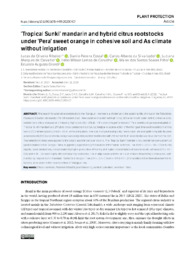'Tropical Sunki' mandarin and hybrid citrus rootstocks under 'Pera' sweet orange in cohesive soil and As climate without irrigation.
'Tropical Sunki' mandarin and hybrid citrus rootstocks under 'Pera' sweet orange in cohesive soil and As climate without irrigation.
Autoria: RIBEIRO, L. de O.; COSTA, D. P.; LEDO, C. A. da S.; CARVALHO, L. M. de; CARVALHO, H. W. L. de; SOARES FILHO, W. dos S.; GIRARDI, E. A.
Resumo: The search for alternative rootstocks to the ?Rangpur? lime tree is a challenge to the sustainability of citrus in the Tabuleiros Costeiros (Coastal Tablelands) of Northeastern Brazil. New varieties should meet high drought tolerance with water deficit, cohesive soils, resistance to citrus diseases and inducing high production of fruit. In this work, the performance of ?Pera? sweet orange was evaluated on ?Tropical Sunki? mandarin and 27 hybrid citrus rootstocks in Umbaúba, Sergipe. A local selection of the ?Rangpur? lime was the control. Planting was in 2013 at tree spacing of 6.0 × 3.0 m, without irrigation. Tree size, fruit yield and quality, tree survival rate and graft-compatibility were assessed until 2019. Experimental design was completely randomized blocks with 29 treatments, three replicates and four plants in the plot. Two selection indices were applied to the data to assist in decision making. The ?Tropical Sunki? mandarin induced similar cumulative fruit yield in relation to the ?Rangpur? lime, suggesting a good drought tolerance of the former rootstock. The TSKC × (LCR × TR) - 073 induced slightly lower productivity, compensated by higher productive efficiency and higher concentration of soluble solids, whereas LCR × TR - 001 and HTR - 166 were highly efficient dwarfing rootstocks. The multiplicative and the rank sum indices showed high correlation, both classifying ?Tropical Sunki? mandarin, ?Santa Cruz Rangpur? lime, LVK × LCR - 010 and - 038, HTR - 127, in addition to the three aforementioned hybrids, as superior to the local selection of ?Rangpur? lime.
Ano de publicação: 2021
Tipo de publicação: Artigo de periódico
Unidade: Embrapa Mandioca e Fruticultura
Palavras-chave: Laranja
Observações
1 - Por padrão são exibidas publicações dos últimos 20 anos. Para encontrar publicações mais antigas, configure o filtro ano de publicação, colocando o ano a partir do qual você deseja encontrar publicações. O filtro está na coluna da esquerda na busca acima.
2 - Para ler algumas publicações da Embrapa (apenas as que estão em formato ePub), é necessário ter, no celular ou computador, um desses softwares gratuitos. Sistemas Android: Google Play Livros; IOS: iBooks; Windows e Linux: software Calibre.
Acesse outras publicações
Acesse a Base de Dados da Pesquisa Agropecuária (BDPA) para consultar o acervo completo das bibliotecas da Embrapa.

